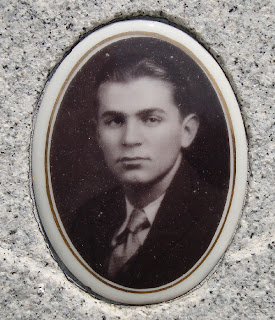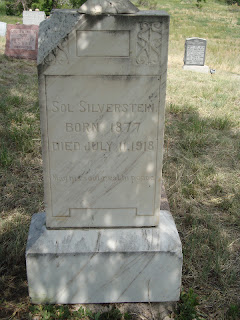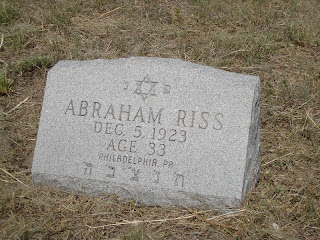Golden Hill’s first burial was in 1908, and in 1995 the
“hill section” was added to the National Register of Historic Places.
It’s #94001230. The “hill section” is the part we were most interested in; it’s
the part toward the northwest, and was reserved for tuberculosis victims, suicides,
and indigent burials. Other parts of the cemetery are still active, but with
one exception, the hill section is full of older plots.
 |
| Alex holding the "Historic Denver" sign. |
 |
| Looking from the northwestern area, near the gate. |
 | |
| From slightly farther south. |
(You can see in a lot of the images that there have been
stones left on the graves. As I understand it, this is a traditional way to
show that one has come to visit and pay respects to someone. This link has some more on that.)
There were a lot of tuberculosis deaths in Colorado, though
many of the people who died were not from here initially. Back in the 1910s
even up through the 40s and 50s, it was thought that the dry air of Colorado
would help cure or relieve tuberculosis, so people were sent here from all over
the country. Many of the burials in the hill section were courtesy of the Jewish
Consumptives Relief Society, or JCRS.
If you’d like to know more about the cemetery, this blog entry has some really great information.
Just to make it clear, this is in no way a comprehensive
list of those buried here; these are just a few of many, many headstones and
other markers.
Starting near the gate, there are several rather elaborate
stones. One in particular was especially visible from the road.
 |
| Not many have fences outlining the plot. And you can't really tell but the headstone is probably 6 or 7 feet tall. |
 |
| Closeup of her portrait. |
There were a few others we saw that included portraits. I’ve
always thought those were especially beautiful.
 |
| I managed to cut off the lower plaque, but it actually mentions the JCRS. |
 |
| According to one of the links I posted above, this was a memorial probably added later, maybe by family. There's a partial translation at the link I posted for more information on the cemetery. |
Sadly, some stones obviously once had portraits, which have since been broken or stolen.
There’s a lot of variation when it comes to the style and
quality of the headstones. I have to say that’s one thing that I like about
older cemeteries; many newer ones have rules about all headstones having to be
essentially identical.
 |
| This is the only stone I've seen made of this particular material. It seemed to be granite, but was a very dark red, rather than the usual pink. |
 | |||
| Another unique marker. Iron, painted a copper color. |
 |
| The only recent headstone we saw. Burial in 1996. |
As you go south from the gate, many of the graves become
obviously poorer. There are many pauper’s graves, marked only by small metal
markers that have long since lost whatever information they once had. A couple
still had bits of glass in the metal frames, and one even had remains of paper,
which maybe once had the information on the person buried there. It’s obviously
completely unreadable now.
Farther south, there were also more obviously hand-carved
stones. I’m used to seeing that in the historic cemeteries I’ve visited in
Colorado and New Mexico. Many of these looked like they were carved by the same
person.
 |
| This one was almost right up against the fence, making it hard to read. It does say they were born in Russia, which is apparently where many of those interred here were from. |
And unfortunately, that portion of the cemetery is also less
well maintained. The whole site has been cleaned up, but there are more fallen
stones the farther south you go. I’m not sure if they’ve fallen naturally, or
through vandalism. Vandalism in a cemetery seems very, very sad to me.
Now this bit is entirely subjective, but this is one of the
few (honestly, the only that I can recall) cemeteries that’s given me a
“feeling” or a “vibe” or whatever you’d like to call it. I have gotten feelings like that in other places, but
generally cemeteries just feel “quiet” to me, which I figure is more just the
nature of what they are rather than anything else. This particular one didn’t
feel malevolent in any way, or threatening, or frightening. But it felt
immensely sad the farther south we got.
Alex actually mentioned it first, saying he was getting a
weird feeling. And at almost the same instant, we both said “it feels sad.” We
agreed that we hadn’t felt much of anything out of the ordinary when we were up
by the gate, but the farther south we got, the sadder it felt. I thought about
it just being that it was an obviously poorer section, but that’s not uncommon
in older cemeteries like this, and neither of us have reacted that way before
to a cemetery.
And the feeling had a peculiarly external feel to it. I said
before that vandalism seems sad… but that kind of sadness is internal. It makes
me sad as a person to see someone has vandalized a grave, as it makes me sad to
see older cemeteries that are entirely neglected or forgotten. But that’s a
projection of my own feelings. Here it was a feeling that just happened, and didn't feel like it originated in me.
I knew this was largely a site for those who died of
tuberculosis, and I speculated while we were there that if any place had some
kind of residual sorrow, it’d be one that held so many people who died too
young of epidemic disease. It wasn’t until looking up a little more information
after getting home that I found out that it was also used for suicides. That
could very well have added to a sense of despair.
I consider myself an open-minded skeptic when it comes to
spiritual and paranormal matters. But having the both of us get the same
feeling at the same time and place is one heck of a coincidence. I certainly
don’t consider this “proof” of anything, but it was definitely strange.
The cemetery itself is very beautiful, and worth a visit if you enjoy places like this.
The cemetery itself is very beautiful, and worth a visit if you enjoy places like this.















































